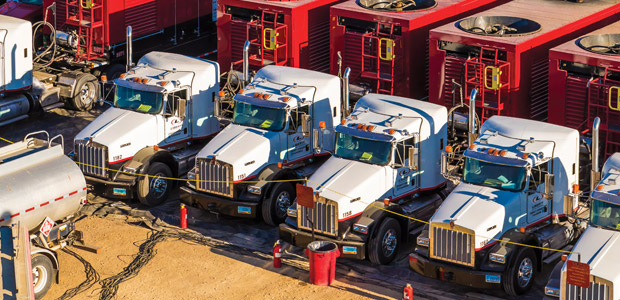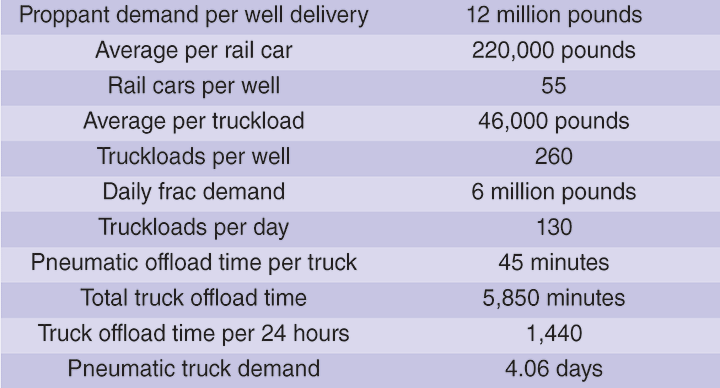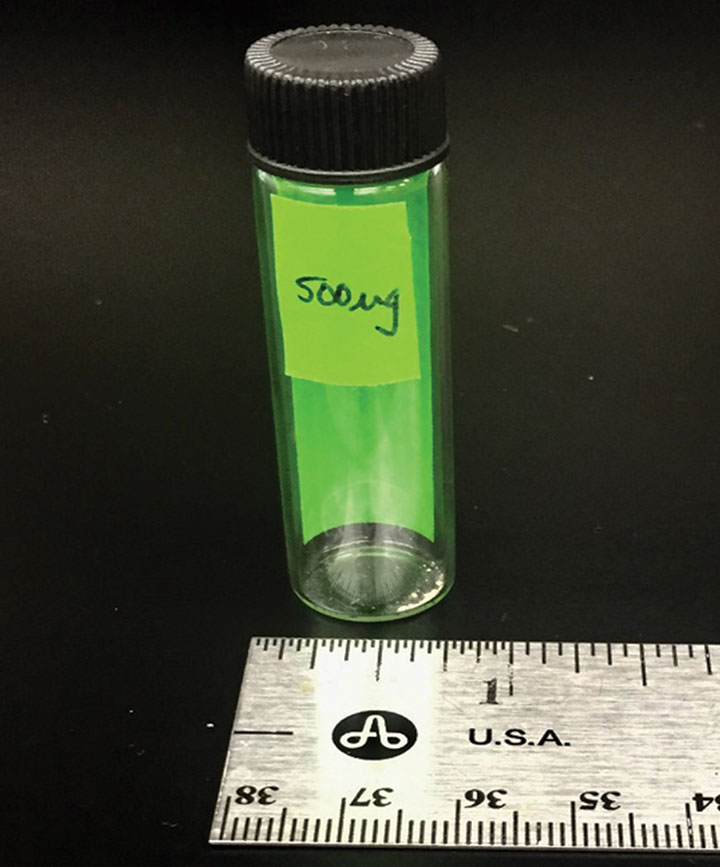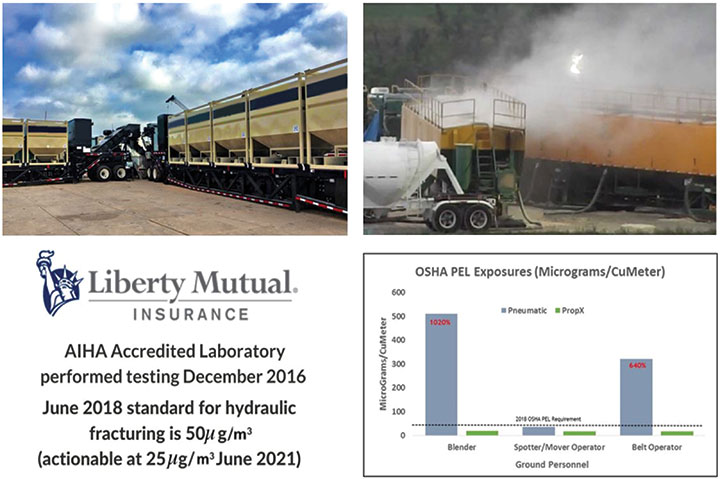
Hydraulic Fracturing Technology
‘Last Mile’ Solutions Enhance Efficiency, Reliability Of Proppant Supply Chain
By Kevin Fisher
DENVER–U.S. proppant consumption is on track to range between 125 billion and 150 billion pounds this year, exceeding the historic volume pumped in 2014. Not surprisingly, the Permian Basin is the largest consuming region, accounting for more than one-third of total U.S. demand. According to IHS Markit and others who track the hydraulic fracturing market, frac sand demand is forecast to be even stronger in 2018, potentially reaching as much as 200 billion pounds.
This unprecedented level of proppant usage is driven by several factors–increased rig productivities, longer laterals, higher stage counts per lateral, and greater proppant concentrations per stage–but it comes down to the simple fact that developing tight oil and gas shale reservoirs requires a lot of capital, technology, horsepower and consumable goods, proppant included.
There is no question that drilling rigs have become much more efficient, to the point that productivity metrics are being redefined by horizontal pad drilling. In fact, according to the chief executive officer of a major service company, drilling penetration rates are so high that 1,000 rigs now drill about the same amount of footage as 2,000 rigs could drill in 2014. The improved productivity is crucial to the bottom-line economics of resource plays.
At the same time, the “frac intensity,” or amount of proppant pumped per foot of horizontal lateral, continues to grow. Recall that in 2014 frac sand logistics already were challenged with sand mine capacity shortages, traffic issues on railways, insufficient in-basin storage and transload capacities, and “last mile” logistics from the transload facility to the wellhead proving woefully challenged to keep pace with demand. It is not hard to imagine that during the historic downturn in oil prices and activity levels, little additional capital was employed to improve the infrastructure necessary to efficiently deliver frac sand. Now that activity levels are rebounding, the entire frac sand supply chain from mine to well may be tested severely.
Sand mines are expanding, with typical effective capacity at around 80 percent of nameplate capacity, and new mines are being permitted. This is especially true in Texas, where local “brown sand” closer to the point of use (as opposed to “white sand” sourced primarily from the Midwest) has come into favor because of its ability to debottleneck from rail capacity constraints and to reduce delivered costs while meeting operators’ technical requirements.
Delivering The Goods
Since sand mine supply must be available to match demand, and assuming railway interruptions can be kept to a minimum, the final pieces (and most controllable from a pumping company or operating company perspective) in the proppant supply chain are transload storage facilities and last mile logistics.
Last mile refers to the transport of sand from in-basin or near-basin storage facilities to the wellhead. Oil field research firm Infill Thinking estimates that the last mile process comprises as much as one-third of the total delivered cost of frac sand. The last mile market is extremely fragmented in terms of the number of players involved, as well as the types of technology employed. For example, in the Permian Basin alone, Infill Thinking tracks more than 40 hauling companies operating significant fleets and many more “mom and pops” running only a handful of trucks.
Typically, frac sand and ceramic proppants are brought from the source (mines or plants) to a storage location in or near the basin where they will be pumped. The most effective method of transportation from sources outside the basin deals with “unit trains” consisting of 110-120 railcars, each containing 200,000-220,000 pounds of proppant. Unit trains have been reported as long or longer than 150 cars, which would stretch more than 1.25 miles long. There are wells being stimulated today which require a full unit train of sand and an average horizontal well now requires half of a unit train load.
Before it can be delivered to the well site, all that proppant has to be unloaded from railcars to trucks or into storage silos at in-basin transload facilities. Coras Oilfield Research reports that there are now about 200 transload facilities in the United States with a cumulative nameplate capacity of 126 million metric tons with these facilities expected to grow their total capacity by 15 percent in 2018.
While this capacity is more than the expected usage in 2018, it is concentrated among the large pressure pumping companies and is also concentrated in only 50-60 unit train-capable facilities. Also, consider that perhaps 30 percent of the capacity of the unit train-capable facilities is contracted by oil and gas companies, putting smaller pressure pumpers and other operators at risk of supply disruptions, and leading to a potential source of bottlenecks in the proppant supply chain.
Numbers For Thought
It is no secret that frac intensity and proppant volumes continue to climb, even as drilling efficiency has gone off the charts in terms of number of wells drilled per rig each year. Consider that proppant intensity is now more than 1,400 pounds per foot of lateral, with several in the U.S. basins at or above 2,000 pounds/foot and some wells reported at as much as 5,000 pounds/foot. A total of 12 million pounds of sand a well is a reasonable assumption for the typical unconventional completion in a two-mile lateral (Table 1). Assuming a typical rail car from a mine holds 220,000 pounds of proppant, the average U.S. horizontal well now requires 55 rail cars full of sand (half of a unit train for every well completed).
Each truck will carry an average of 46,000 pounds of proppant, so transloading those 55 rail cars requires 260 truckloads that must be delivered to the wellhead. Given the standard completion practice of “zippering” multiple wells on a pad, some pads are efficient enough to allow a single frac crew to pump 5 million-6 million pounds or more of sand a day, exceeding 130 truckloads of sand that must be delivered each day to a single pad.
When using pneumatic trailers for delivery, each truckload requires 40-70 minutes to unload, depending on the pressure at which the air pumps are set for blow off (higher pressure means faster unloading, but it also increases proppant damage and stirs more dust). For 130 truckloads of sand at 45 minutes of unloading time a truckload, it takes 5,850 minutes (97.5 truck hours or four full truck days) to unload, so at least four truck unloading slots will be completely utilized all day, every day.
This requires a significant amount of space and perfect execution by the sand coordinators, frac operations crew and drivers to keep that sand flowing to the blender. The only thing that a frac crew leaves behind at the end of a project is the sand that it places in the ground, and a crew can ill afford to suspend operations while waiting on sand.
Last Mile Delivery Methods
The traditional last mile system is composed of pneumatic trailers that deliver sand to the well site, where it is blown off from the pressurized trailer into a “mountain mover” or “sand king,” a large storage trailer that typically consists of five separate bins, each holding the contents of a trailer. The blow-off operation utilizes an air pump connecting to piping on the bottom of the trailer, and literally blows the sand from the trailer into the sand king. Typically, several sand kings are employed and dump onto a T-belt, which feeds into the blender. This operation is noisy because of the high-pitched whine of the blower pumps, dusty in the absence of additional dust control measures, congested with truck positioning and time consuming.
Because of the large number of sand trailers required to “feed the beast” of a frac operation, and because a pumping company cannot afford to prematurely run out of sand and terminate a frac or delay the next frac stage, there are generally a dozen or so trucks lined up ready to blow off when their turn comes. This leads to a traffic nuisance for nearby residents and commuters and to stand-by or “demurrage” charges by the trucking companies. In addition, this increases the congestion and health, safety and environmental exposure on the frac site as truckers back into position and prepare blow lines while others pull off location after emptying.
The advantage of the legacy blow-off method is that there is a lot of pneumatic equipment available, with around 500 U.S. frac fleets utilizing this delivery method in 2014 featuring crew members knowledgeable in how to use the system. Negatives include the length of time necessary to unload a pneumatic trailer, with the determining factor being air pump pressure.
As noted, the higher the air pressure, the faster the trailer unloads. But frac sand can be damaged by air pressures exceeding 20 psi, and higher blow-off air pressures mean more silica dust, which not only can damage the conductivity of the proppant pack, but the respirable dust is harmful and must be captured. Unfortunately, more respirable silica dust is generated with both smaller proppant mesh sizes and at higher blower pressures.
It should be noted that new Occupational Safety & Health Administration regulations take effect in July 2018 to limit on-site employee silica dust exposure to 50 micrograms a cubic meter, eventually actionable at 25 micrograms. Figure 1 shows 500 micrograms of respirable silica dust, which is the equivalent of the maximum exposure volume allowed under the new OSHA regulations during a worker’s shift.
A newer type of system consists of portable silos that are erected temporarily at the well site ahead of the fracturing process and allow anywhere from 2 million to 20 million pounds of sand to be pre-stocked in the silos. As the job progresses, the stored proppant is fed onto a belt or directly into a frac blender. The system can be useful when time is available to preload the silos to ensure a full load of sand is available before the frac operation starts. The pre-stocked volume can be enough to support one-four days’ worth of frac sand supply, after which it must be replenished with the required daily consumption rate.
Typically, the silos are loaded using pneumatic trailers, with the sand blown up into the silos to fill them. Unloading the pneumatic trailers requires the same amount of time (45 minutes a trailer on average), and generates the same amount of dust, noise, onsite truck traffic congestion and trucking standby charges.
Mobile Containers
The latest last mile technology involves mobile containers that combine many of the portable silo’s benefits, including pre-stocking sand on location prior to an operation, but add a significant new benefit: much faster unloading. The portable containers are hauled to the well site on flatbed or drop-deck trailers and are clipped onto the trailers with ISO quick clips that can be locked or unlocked very quickly so that a load of containerized sand, similar in volume to that of a pneumatic trailer, can be unloaded by a forklift, replaced with empty containers, and sent on its way back to the transload facility for its next load in fewer than than 10 minutes.
This speedier method for dropping off a load of sand eliminates the necessity for trucks to line the road as they wait to blow off (which translates to happier neighbors and commuters). Furthermore, it shrinks pollution caused by idling trucks, opens more space around the well site and trims costs associated with trucking standby charges. Because the mobile containers discharge sand onto a conveyor through a gravity-fed opening in the container rather than through an air blower, these systems are far quieter and stir far less dust than pneumatic sand discharge.
Moreover, since a significant volume of sand can be pre-staged on the well site and empty containers on the conveyor system can be replaced quickly by a forklift, systems with high-capacity conveyors can deliver sand more quickly to the wellhead than a typical arrangement with multiple sand kings feeding a T-belt. A single frac crew recently pumped almost 9.3 million pounds of sand in a 24-hour period, a throughput feat unheard of with legacy pneumatic systems and quite possibly a daily record for a single frac crew.
FIGURE 2
Proppant Delivery using Gravity-Fed Mobile
Containers (Left) versus Pneumatic System (Right)
Because trucking standby charges are minimized and flatbed hauling is typically more competitively priced than pneumatic transports or custom trailers, the cost per pound-mile to deliver sand can be significantly cheaper. Compared with the cost of legacy pneumatic sand hauling, mobile containers save money, reduce truck traffic, and are cleaner and quieter. In many cases, in fact, a pumping service company can stack any sand kings and pneumatic trailers it owns and recover enough cost savings through lower-cost trucking of mobile containers to more than compensate for the depreciation on entire fleets of older stacked sand moving equipment.
Figure 2 shows pneumatic delivery without dust control (right) compared with gravity-fed mobile containers (left). Both photos were taken during pumping operations. The graph at bottom right shows measured exposures by the same industrial hygienist during frac operations with pneumatic transfer equipment and during a mobile container operation. The 2018 OSHA standard is shown in the dashed line.
The Way Forward
If frac sand intensity continues to grow and the number of lateral feet to be stimulated continues to increase, the domestic industry likely will require an “all of the above” solution to the proppant supply chain.
Given their legacy market share and availability, pneumatics will remain in use, albeit with more stringent dust capture requirements to meet the new OSHA regulations. They will be most effective in remote areas where noise and truck traffic concerns are less of an issue than in more urbanized and populated areas. On-site storage silos can be particularly effective during the first few days of a large frac operation and are generally able to deliver large amounts of proppant to the blender if they can be replenished efficiently. Mobile containers will fill the remaining void to ensure that last-mile logistics do not become a major pinch-point in the supply chain.
Other technologies are being employed to assist in the overall proppant supply chain in addition to unit train-capable mines and transload facilities, which have proven far more efficient than manifest shipments of partial trains that must be broken up during the journey. Technologies such as tracking shipments on rails, and now even on trucks carrying the proppant to the well site, provide visibility into the “just-in-time” delivery of proppants so that a frac crew always knows how much proppant volume is stored on site and how many truckloads are in transit from a given terminal (along with their expected arrival times). This allows for a more efficient staging of supply to eliminate truck traffic backups and supply shortages.
This is being accomplished with friendly smart phone applications connected to cloud-based databases, reducing the amount of time a crew member spends calling dispatchers, logistics partners, truckers and terminals to track proppant shipments. The ideal technology is a combination of Amazon Prime for shipment ordering and tracking, Uber for selecting optimum carriers and drivers based on U.S. Department of Transportation ratings, weight permits and current location, plus Google Maps for route optimization.

KEVIN FISHER is chief executive officer of Denver-based PropX LLC, which provides last-mile proppant delivery solutions. Before joining the company in 2016, he served as president of Liberty Oilfield Services and as executive vice president of business development at Flotek Industries. Fisher began his career in 1979 with Halliburton, and served for 14 years as a logging engineer, field supervisor, log analyst, U.S. sales manager and global technical marketing manager. He joined ProTechnics in 1993 as director of sales and marketing, and moved to Pinnacle in 2000, ultimately serving as chief executive officer. He has a B.S. in natural science and physics from Cameron University and is a graduate of Harvard Business School.
For other great articles about exploration, drilling, completions and production, subscribe to The American Oil & Gas Reporter and bookmark www.aogr.com.


















